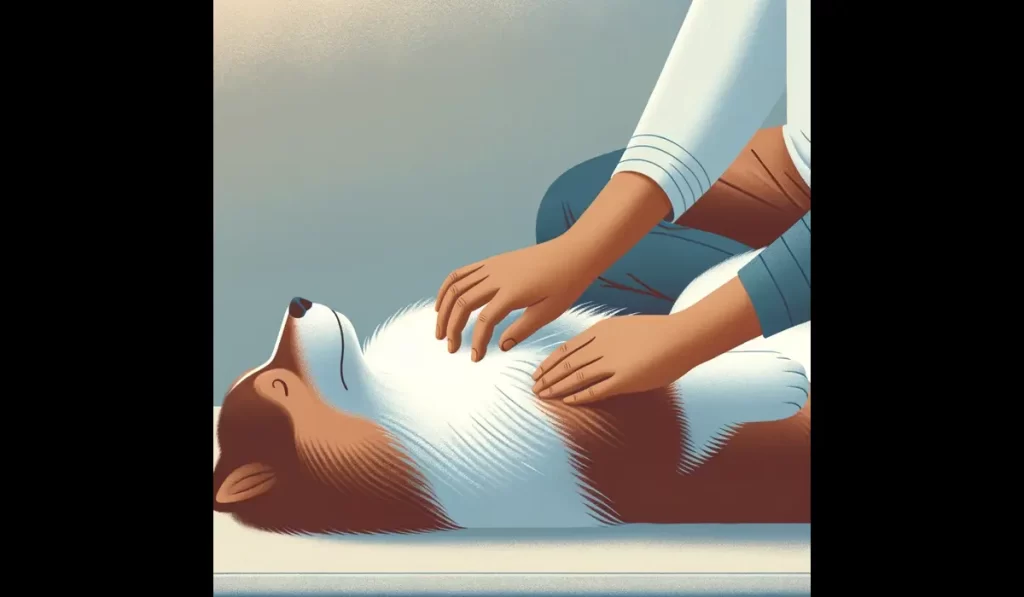Summary
To help your gassy dog, gently massage their abdomen in circular motions or long downward strokes while they lie on their back. Focus on any hardened areas near the hips. Prevent gas by slowing down eating with slow feeders, offering smaller, frequent meals, and feeding a high-quality, easily digestible diet, avoiding table scraps and known gas-inducing ingredients. Regular exercise aids digestion. Consult your vet about probiotics. Seek immediate veterinary attention if gas is accompanied by severe bloating, vomiting, diarrhea, loss of appetite, lethargy, or abdominal pain, as these could indicate a more serious underlying issue.
What is a Passing Gas?
Passing gas, scientifically known as flatulence, results from a gas buildup in your dog’s intestines. Usually, gas is produced during digestion & gets trapped in the digestive tract, which is then released through the anus or the mouth.
Gas production is a normal body function that does not cause panic unless any of the symptoms mentioned below accompany it.
How is Gas Caused in Dogs?
The production of gas is expected in your dog’s body & is just like the production of sweat, poop, etc. If you have recently noticed that your dog’s farts have become smelly or excessive, they cause concern.
Until then, do not worry about gas naturally produced in your dog’s stomach. There are various causes for gas production, which are listed below.
Indigestion
Also described as ‘inhalation of food,’ devouring food without proper chewing causes food to go through the digestive tract without being fully digested. When this undigested food reacts with the bacteria in the intestine, it causes gas production in your pet’s stomach.
Indigestion can also be an inherent trait that needs to be noticed by you & required tests need to be run to ensure that a solution to the problem is found in the form of medication or any alternative provided by your vet.
Excessive Inhalation of Air
If your dog is used to eating rapidly, it ingests food faster. Still, the amount of air that enters your pet’s mouth is also more significant when compared to thoroughly chewing food. The air that has entered is gas trapped with no exit, except in the form of flatulence.
Changes in Diet
Introducing new food items that may be difficult to digest, explicitly referring to foods including milk products, beans & highly fatty foods, can cause gas production.
However, it is challenging to pinpoint one food as the cause of gas & professional vets can only do this after running tests.
Ingestion of Spicy Food
Spicy food irritates the inner lining of your dog’s stomach. The capsaicin in spicy food can cause diarrhea, vomiting, and gas.
Other symptoms of feeding your spicy dog food are loss of appetite, dehydration & lethargy.
Quality of Dog Food
Ensure that the dog food you feed your dog is of high quality. It is important only to feed it substandard quality food that provides low nutritional value, which defeats the purpose of feeding it.
Feeding Right after Strenuous Activity
Suppose you feed your dog immediately after high-intensity activities like exercising. In that case, it will likely inhale as much air as it would be panting.
What are the Symptoms of Gas in a Dog?
Bloating
An expansion in the stomach & intestines due to gas is called bloating, scientifically termed Stomach distension in normal conditions.
At this stage, it is not threatening to your dog’s life. However, it is termed Gastric dilatation-volvulus when the bloated parts begin to twist & pose a severe threat to your dog’s life.
Foul-Smelling Farts
If you notice a change in the odor of your dog’s farts, it may be an indication of a gassy digestive system.
Abdominal Discomfort
Inflammation & irritation of the stomach and intestines cause discomfort to the dog. Immediate notice should be taken & proper medical care should be provided to deal with the problem. Audible rumbles from the stomach may also accompany this.
Does Belonging to a Certain Breed Increase Susceptibility to Gas?
Dogs that are not fit tend to suffer more health issues than fit dogs. If your dog is overweight or obese, it is likely to suffer from excessive gas buildup even while on a well-balanced, high-quality diet.
An immediate action step is to prevent your dog from being sedentary by taking walks & playing with your pet.
Breeds with shorter noses take in more air while panting & eating, which may be the cause of excessive farting.
How can I help my dog pass a gas massage?
If your dog is experiencing excessive gas, there are a few things you can do to help them pass it. One option is to massage your dog’s abdomen using circular motions gently.
This can help promote gas movement through the digestive tract and make your dog more comfortable. You can also try feeding your dog small, frequent meals instead of one large meal, as this can help to prevent bloating and gas.
Additionally, you can try giving your dog a digestive enzyme supplement or adding a small amount of canned pumpkin into their food, as these can help to improve digestion and reduce gas.
Suppose your dog’s gas persists or you are experiencing other symptoms, such as vomiting or diarrhea. In that case, it is important to consult your veterinarian for further guidance.
Can the Buildup of Gas be Prevented?
While every dog owner’s priority is to keep their dog healthy, you must be prepared for common circumstances such as gas and bloating to relieve your dog of the pain it could be suffering. And hence, the buildup of gas can be prevented.
- Keep track of any changes that you make in your dog’s diet. The introduction of any new substance belonging to any food group must be carefully kept track of & intake should gradually be increased.
- Avoid feeding your dog any scraps of food to avoid wastage. The food contents must be carefully examined before feeding your dog.
- Check the nutritional content of food before feeding it to your dog. Ensure that it is high quality & not very high in fiber to prevent indigestion, as your dog’s digestive system is not adapted to digest it.
- Try feeding your dog small amounts of yogurt, ginger, or edible peppermint after your vet’s approval to aid digestion.
- Avoid fart-inducing foods in your dog’s diet.
- Keep your dog in a healthy state to avoid health issues.
- Train your dog to eat slowly using products designed to help slow their eating pace.
- Regular massages can help ease the gas in your dog’s stomach while relieving stress & aiding mobility.
How to Massage Gas Out of Dog?
This section focuses on how to ease your dog’s discomfort by massaging your pet’s stomach to get gas out of its stomach.
Get Your Dog to Roll Over
This may not be the best time to give commands to roll over while your dog is experiencing extreme pain on the inside.
Likely, your dog would already be in a down position as it is in pain. The first step to giving a dog massage is to gently nudge your dog onto its back to lie down on its back with its stomach exposed.
Identify Affected Area
Rub your hand lightly over your dog’s abdomen to inspect for any hardening. Use just your palm for the inspection.
Please take notice of any hardened areas on its abdomen, as this is where the gas has built up. Focus on the areas near the hip & hind legs. Massaging those areas can help debloat, relieve gas & stress, and sleep.
Work on the Spots
Now that the problem area has been identified, light pressure should be used to massage the area in a particular direction, preferably downwards. Rub the layer underneath the spot. Slightly squeeze the body to relieve your dog & get rid of the gas.
How to Relieve Dog Gas Pain?
Use long strokes slowly to run across the bloated area. Ensure that you do not apply too much pressure. You aim not to go deep but deep enough to relieve the pain.
The right way to massage is to stroke your dog’s abdomen in any direction, making sure to start at the hardened spot & go outwards.
Ensure that Your Dog is Relaxed
Remember that the massage’s objective is to relieve your dog from the internal pain caused by gas. A clear indicator is your dog’s mood. If your dog is slowly relaxing on its back, then your pace & strength application is ideal.
Make sure you check your dog for indications of discomfort. The proper massaging technique would cause your dog to lean back very close to you with its eyes almost closed.
Suppose you do not notice the softening of the hardened areas. In that case, it may be a sign that the issue is more significant than it appears at the surface & medical intervention is required.
Can the Buildup of Gas Lead to Further Issues?
After close monitoring, if the only signs of gas are bloating, smelly farts &/or rumbling from the abdomen, this may be a typical case of gas accumulation that can be relieved through massage.
However, suppose any other signs, such as vomiting & diarrhea, are identified. In that case, it is advised to rush to your vet immediately as it may lead to an extremely painful and life-threatening situation for your dog.
These symptoms could indicate intestinal parasites or inflammatory bowel disease in your dog. Knowing how to massage the gas out of the dog can help detect such issues as soon as possible by tracking related symptoms.


